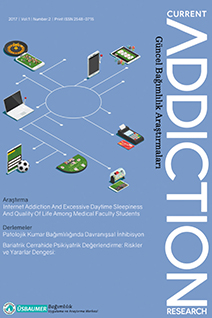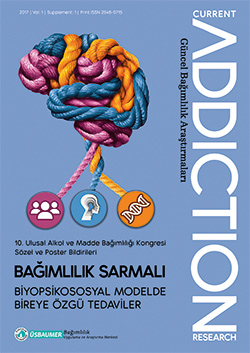Years
2025
2024
2023
2022
2021
2020
2019
2018
2017
Categories
Authors
- AYŞEGÜL DUMAN (1)
- Ahmet Tamer AKER (1)
- Ahmet Üzer (1)
- Ali Yücel GÜLER (1)
- Aslı Enez Darçın (1)
- Aslı Kayacan (1)
- Aslıhan Polat (1)
- Ayşegül Tosuner (1)
- Azize TÜRKOĞLU (1)
- Başak Ünübol (1)
- Berhudan Şamar (1)
- Beyza Yaz (1)
- Birgul Kekliltepe (1)
- Bülent COŞKUN (1)
- Cemal Onur NOYAN (3)
- Cemal Onur Noyan (2)
- Ceren GÜNGÖR (1)
- Ceylan Ergül Arslan (2)
- Davut Genç (1)
- Deniz Doğan (1)
- Deniz Eryılmaz (1)
- Derya Gündüz Hoşgör (1)
- Didem Beşikçi Keleş (1)
- Dilan Erkan (1)
- Ekin Sönmez Güngör (1)
- Elif Mutlu (1)
- Erkal ERZİNCAN (1)
- Erkal Erzincan (2)
- Fatma Betül Esen (1)
- Fatma Eren (2)
- Feyza ÇELİK (1)
- Gizem Akülker (1)
- Gul Eryılmaz (1)
- Gökben Hızlı Sayar (1)
- Gül ERYILMAZ (2)
- HANDE TUĞÇE DEMİRCİ (1)
- HATİCE OKSAL (1)
- Habib Erensoy (1)
- Hasan Kaya (1)
- Hasan Mervan Aytaç (1)
- Hatice Turan (2)
- Haydar Hoşgör (1)
- Hüseyin Ünübol (2)
- HİLAL ÇERKEZOĞLU (1)
- Hızlı Sayar Gökben (1)
- Işıl Gogcegoz (2)
- Işıl GÖĞCEGÖZ (1)
- Kursad Nuri Baydili (1)
- Lütfiye Nur Akkoç Arabacı (1)
- Melike Yerebakan Tüzer (1)
- Merve Metin (1)
- Meryem Zeynep Uğurlu (1)
- Mine Ergelen (1)
- Murat Yalçın (1)
- Nermin GÜNDÜZ (2)
- Nermin Gündüz (2)
- Nesrin Dilbaz (2)
- Nevzat Tarhan (1)
- Nilüfer SAATCİOĞLU TINKIR (2)
- Nisanur Sarıgül (1)
- Nuran Korkmaz (1)
- Onur Gökçen (1)
- SALİH GÜLEN (1)
- Selim Arpacıoğlu (1)
- Sema AKKOYUN (1)
- Serdar Nurmedov (2)
- Sevinç Sütlü (1)
- Sümeyra Bilgiç (1)
- Tijen Acar (1)
- Tonguç Demir Berkol (1)
- Tuba Öcek Baş (1)
- Tuğba Yılmaz (1)
- Yasin Hasan Balcıoğlu (1)
- Zehra Arıkan (1)
- Zeynep Ülke (1)
- Zeynep Şahin (1)
- Zühal Albayrak (1)
- Çağrı Yalçın Çınar (1)
- ÖMER BÜBER (1)
- Özge Kutlu (1)
- Özge Nur Kutluer (1)
- Özge Timur (1)
- İrem Teke Bulut (1)
- Şule DOYAROĞLU (1)
ARTICLES
Original Article
Ceren GÜNGÖR,Cemal Onur NOYAN
2023, 7(2), s:13-18
Objective: This study was designed to investigate the relationship between family involvement, stigmatization, perceived social support, and treatment motivation in drug addiction treatment.
Method: The participants of our study consisted of individuals receiving substance use disorder treatment at the NP Brain Hospital AMATEM service and the Green Crescent Counseling Center (YEDAM). The research included a total of 98 voluntary participants, including 88 males and 10 females, aged 18 and above, receiving substance use disorder treatment. Among the participants, 57 had family involvement in the treatment, while the remaining 41 did not have their families involved in the treatment process. Data were collected using the Personal Information Form, the YEDAM Substance Addiction Stigmatization Scale (YMBSÖ), the Multidimensional Perceived Social Support Scale (ÇBADÖ), and the Treatment Motivation Questionnaire (TMA).
Results: When the results were evaluated, a significant relationship was found between the family subscale of perceived social support and the treatment confidence subscale of the treatment motivation questionnaire. Among the subscales of the Treatment Motivation Questionnaire, the score for seeking interpersonal help was higher in patients whose families were involved in the treatment. When the stigma scores of participants living alone were compared with those living with their families, it was concluded that individuals living alone had higher stigma scores.
Conclusion: The findings from our study have shown that substance addiction negatively affects many essential aspects of patients' lives, such as their social relationships, family and environmental connections, as well as their work and academic lives. Substance addiction, which is becoming an increasingly significant societal issue, requires a multidisciplinary approach that involves not only medical treatment but also the involvement of families and society in order to regulate individuals' social lives, education and work lives, and family and environmental relationships.
Original Article
Fatma Betül Esen,Ahmet Üzer,Lütfiye Nur Akkoç Arabacı,Sümeyra Bilgiç,Meryem Zeynep Uğurlu,Nisanur Sarıgül,Deniz Doğan,Zeynep Şahin
2023, 7(1), s:9-16
Objective: Covid-19 outbreak, which was declared a pandemic on 11.03.2020 by the World Health Organization (WHO), affected Turkey too and the first case in Turkey was detected on March 11, 2020. With mandatory restrictions, internet use has become increasingly inevitable in the Covid-19 pandemic. In this study, we aimed to investigate the change in the gaming behavior and smartphones usage in adult individuals during the Covid-19 Pandemic and the relationship between these behaviours and experiential avoidance.
Method: In this study, 269 paticipants between the ages of 18 and 65 who met the inclusion criteria were recruited between the dates 08.01.2022 and 28.03.2022. Participants were given 5 scales which were; Socio-demographic Data Form, Smartphone Addiction Scale – Short Form (SAS-SF), Internet Gaming Disorder Scale (IGDS9–SF), Multidimensional Experiential Avoidance Scale – 30 (MEAQ–30), and Acceptance and Action Form–2 (AAQ-2).
Results: 60.8% of the participants stated that the duration of smartphone usage increased and 71.5% stated that the gaming time did not change during the pandemic. It is shown that gaming behavior and smartphone usage is related with procrastination which is a subscale of MEAQ-30. Smartphone addiction is predicted by experiential avoidance, procrastination and using time and gaming disorder is predicted by gaming time.
Conclusion: In the current research, on smartphone addiction; it has been observed that it is related to experiential avoidance, especially procrastination sub-scale. Furthermore, the effect of time spent with a smartphone and sleeping with phone affect negatively in terms of smartphone addiction. It is shown that, for gaming disorder, gaming time is the most predictive factor.
Original Article
Ali Yücel GÜLER,Gül ERYILMAZ,Nilüfer SAATCİOĞLU TINKIR
2022, 6(1), s:5-12
Original Article
Feyza ÇELİK,Ahmet Tamer AKER,Nermin GÜNDÜZ
2022, 6(1), s:13-24
Original Article
Erkal ERZİNCAN,Bülent COŞKUN,Nermin GÜNDÜZ
2022, 6(1), s:25-39
Original Article
Nilüfer SAATCİOĞLU TINKIR,Gül ERYILMAZ
2021, 5(1), s:5-15
Original Article
Sema AKKOYUN,Işıl GÖĞCEGÖZ
2020, 4(2), s:47-53
Original Article
Habib Erensoy,Tonguç Demir Berkol,Yasin Hasan Balcıoğlu,Hasan Mervan Aytaç
2020, 4(1), s:5-15
Objective: Comorbidity of substance use disorders and other psychiatric disorders is common. However, data on the prevalence of substance use disorders in general psychiatric outpatient population is rather scarce.
Method: In order to investigate the prevalence of substance use disorders among the patients who admitted to the general psychiatric outpatient unit and followed with any psychiatric diagnosis, 734 consecutive adult patients were included in this study. Michigan Alcoholism Screening Test–AD was administered to these patients. Substance screening form and SCID-I dependence module were administered to 47 patients (6.4%) who had a MAST-AD score above 4. Later, SCID-II and the rest of SCID-I were administered to 33 patients (4.5%) who met any diagnostic criteria on this module.
Results: From these 734 patients, 33 (4.5%) had alcohol or substance use disorder: Five patients (0.7%) had alcohol dependence, 26 patients (3.5%) had alcohol abuse and 3 patients (0.4%) had multiple substance dependence. There were 9 patients (1.2%) with cannabis abuse, 4 patients (0.5%) with ecstasy abuse, 1 patient (0.1%) with heroin abuse, 1 patient with (0.1%) biperiden abuse and 9 patients (1.2%) with benzodiazepin abuse. From this 33 patients, 7 (1.0%) patients were diagnosed with borderline personality disorder, 2 (0.3%) with antisocial personality disorder, 1 patient (0.1%) with paranoid personality disorder, 1 patient (0.1%) with narcissistic personality disorder, 2 patients (0.3%) with avoidant personality disorder, 1 patient (0.1%) with schizoid personality disorder and 1 patient (0.1%) with dependent personality disorder. With SCID-I, we found 5 (0.7%) major depressive disorder, 3 (0.4%) bipolar I, 1 (0.1%) distimic disorder, 2 (0.3%) paranoid schizophrenia, 1 (0.1%) delusional disorder, 3 (0.4%) generalized anxiety disorder, 3 (0.4%) panic disorder, 1 (0.1%) panic disorder with agoraphobia, 1 (0.1%) anxiety disorder not otherwise specified, 1 (0.1%) social phobia and 1 (0.1%) post-traumatic stress disorder.
Conclusion: These results suggest that substance use disorders are not prevalent among general psychiatric outpatients. Substance use disorders should be carefully assessed in patients with diagnoses of mood disorders, anxiety disorders or personality disorders.
Original Article
Evaluation of the Factors Predicting Risky Alcohol Use in University Students
Deniz Eryılmaz,Işıl Gogcegoz,Gul Eryılmaz
2020, 4(1), s:16-20
problem in terms of mental health of the individuals and society. Substance use disorder has been evaluted as a disease by the World Health Organization (DSÖ) from 1951. In terms of alcohol consumption Turkey 4.7% of all deaths in men with prevention of alcohol consumption is predicted of 3.1% of all deaths in women could be prevented. When we analyzed the alcohol consumption in Turkey it’s thought that 4.7% of male deaths, and 3.1% of female deaths could be prevented through prevention of alcohol consumption. Risky alcohol use can be defined as the consumption of alcohol at the risk of harm in physical, mental or social areas. Participants of this study are the students at Üsküdar University in the 2018-2019 academic year. The Alcohol Use Disorders Identification Test was used to determine the alcohol use levels of the participants and to determine the risky alcohol use. According to the results of this study, the rate of individuals who have risky alcohol use is 6.3%. Risky alcohol use has become an important public health problem in terms of mental health of individuals and society.
Original Article
Assessment of University Students' Perspectives On Smokeless Campus Policy
Birgul Kekliltepe,Işıl Gogcegoz
2020, 4(1), s:21-27
The cigarette is an addictive substance being used worldwide and one of the largest risk factors for health. Due to the different substances in the cigarette, smoking can cause different diseases from skin problems to cancer. It`s the biggest cause of preventable illness and deaths in almost every country in the world. In the most developed contries many studies are done against smoking. In the last few years studies on smoking are done in our country too. One of the important examples we gave to the while world is a prohibition of smoking in public places. Tobacco free public places means that all indoor workplaces and indoor public places should be completely smokefree. Cigarette smoking is very common among college students. Many studies are made to prevent this establishing campus-wide tobacco/smoke-free environments. The main aim of this study is to evaluate the perspective of Üsküdar University students on smokeless campus policy. 414 students participated in the study. The study was based on 3 different test which were provided to all participants; Sociodemographic form, Smokeless Places Assessment Form and Fagerstrom Test for Nicotine Dependence. The analysis has shown that non smokers give more support to Smokeless Campus policy than the smokers. It was determined that the level of addiction did not cause statistically significant differences. Keywords:



 2. Sayı
2. Sayı
 1. Sayı
1. Sayı
 Ek Sayı
Ek Sayı







